by W.S. Cranshaw* (7/14)
Quick Facts…
- Conifer seed bugs are a common fall and winter nuisance in Colorado homes.
- They develop on seeds of various plants, particularly pines.
- They have a somewhat bizarre appearance and may produce a piney defensive odor when disturbed. However, they are harmless to people and do not breed indoors.
- They can be difficult to completely exclude from homes. Careful sealing of exterior openings in late summer and early fall is particularly important.
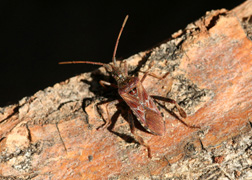
Figure 1: Western conifer seed bug. |
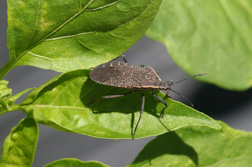
Figure 2: Squash bug. |
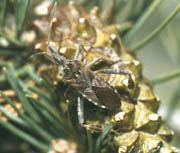
Figure 3: Western conifer seed bug. (Photo by Whitney Cranshaw.) |
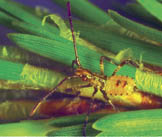
Figure 4: Conifer seed bug nymph. (Photo from the Ken Gray Collection.) |
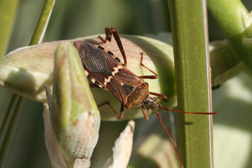
Figure 5: Western leaffooted bug (Leptoglossus clypealis), a leaffooted bug common on various fruits and flowers. |
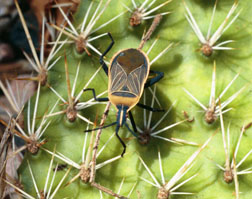
Figure 6: Opuntia bug. |
Conifer seed bugs (Leptoglossus occidentalis) are a common fall and winter nuisance in Colorado homes. They are fairly large insects (about 5/8 to 3/4 inch long) and look rather bizarre. They fly readily and can produce an odd, somewhat piney odor when provoked. These behaviors can alarm homeowners. However, conifer seed bugs are harmless.
Members of the leaffooted bug family, they eat seeds and do not bite people. They enter homes in search of warm, protected sites to overwinter. This habit is shared by many other insects, such as boxelder bugs and elm leaf beetles. They do not reproduce in the home or damage household items. Conifer seed bugs usually die in a week or two if not allowed to drink water.
Life History and Habits
Conifer seed bugs primarily feed and develop on seeds of various trees and shrubs. They prefer pines, Douglas-fir and other conifers but feed on developing seeds and fruits of a wide variety of plants, including dogwood and sumac.
The insects overwinter as adults under protective debris and other shelter. Frequently, they move into nearby homes where they may cause concern. However, during the cool season they are semidormant. They neither reproduce nor feed, but rather live off fat reserves.
In spring, the insects move to trees and feed on male flowers and year-old cones. Beginning in late May, females lay eggs glued in small groups to needles and leaves. The immature or nymph stages somewhat resemble wingless adults. Nymphs feed on the seeds through the summer. They become mature in August and September. Adults continue to feed on cones until they move to winter shelter. There is only one generation per year.
Control in the Home
There is probably little that will effectively control the occasional nuisance movement of conifer seed bugs into homes. The best action is to ensure that homes are well sealed during September and October, when most insects migrate from trees to buildings and other winter shelter. It is probable that insecticide applications to building exteriors, particularly directed at cracks and openings where the insects may enter, should assist in reducing numbers found indoors. However, insecticides have not been tested against these insects. Do not use insecticides to control insects already in the home. Swatting, vacuuming or otherwise disposing of individual insects is the appropriate response.
Related or Similar Insects
Several insects of the leaffooted bug family (Coreidae) occur in Colorado and some of these occasionally are found around homes. During summer, the western leaffooted bug (Leptoglossus clypealis) is sometimes abundant and may temporarily cluster on the outside of buildings. This species is quite similar in appearance to the western conifer seed bug but is more common in lower elevation and grassland parts of the state. It develops on a wide range of native shrubs and flowering plants, and
is often found on yucca flowers. The squash bug (Anasa tristis), a notorious pest of gardens in many parts of the state, will sometimes enter homes in late summer although they are never a very abundant nuisance pest in buildings. Similarly the opuntia bug (Chelinidea vittiger) may sometimes be found around homes when it moves off opuntia cacti seeking winter cover.
Western conifer seed bugs are also sometimes mistaken for assassin bugs (Reduviidae family). They may similarly share an overall elongate body form and pointed head but there are many physical differences to separate them. Perhaps most obvious is the broad thickening of the hind legs on the wester conifer seed bug. Assassin bugs lack this and usually have a slightly thickened pair of front legs instead. The mouthparts of assassin bugs are more conspicuous, forming a pointed beak that projects from the front of the head. The mouthparts of the leaffooted bugs are tucked more closely to the body. It is important to distinguish these two types of insects because of their very different habits. Among these are that assassin bugs, unlike the leaffooted bugs, can bite.
Because of the odor associated with the western conifer seed bug it is also sometimes called a ‘stink bug’. Stink bugs are a different type of insect with a broad body form. Another groups of insects that produce defensive odors are the “stink beetles” also known as “circus beetles” or “skunk beetles”. These are dark beetles that may be observed crawling across the prairie and do occasionally wander accidentally into homes in summer.
*Colorado State University Extension entomologist and professor, bioagricultural sciences and pest management. 2/99. Revised 7/14.
Colorado State University, U.S. Department of Agriculture and Colorado counties cooperating. Extension programs are available to all without discrimination. No endorsement of products mentioned is intended nor is criticism implied of products not mentioned.
Go to top of this page.





